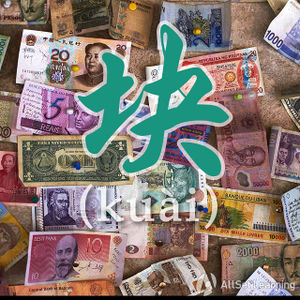Difference between revisions of "Counting money"
m (Text replacement - "duōshǎo" to "duōshao") |
m (Text replacement - "{{HSK|HSK1}}" to "{{HSK|HSK1}}{{2021-HSK|HSK1}}") |
||
| (2 intermediate revisions by 2 users not shown) | |||
| Line 100: | Line 100: | ||
=== Books === | === Books === | ||
| + | {{Source|HSK Standard Course 1|59}} | ||
{{Source|A Practical Chinese Grammar For Foreigners (外国人实用汉语语法)|88-9}} | {{Source|A Practical Chinese Grammar For Foreigners (外国人实用汉语语法)|88-9}} | ||
{{Source|Integrated Chinese: Level 1, Part 1 (3rd ed)|233-4}} | {{Source|Integrated Chinese: Level 1, Part 1 (3rd ed)|233-4}} | ||
[[Category:A2 grammar points]] | [[Category:A2 grammar points]] | ||
| + | {{HSK|HSK1}}{{2021-HSK|HSK1}} | ||
{{Basic Grammar|块|A2|Number + 块 / 元 (+ Number + 毛 / 角) (+ 钱)|给 你 五 <em>块</em> 三 <em>毛</em>。|grammar point|ASGL6JOE}} | {{Basic Grammar|块|A2|Number + 块 / 元 (+ Number + 毛 / 角) (+ 钱)|给 你 五 <em>块</em> 三 <em>毛</em>。|grammar point|ASGL6JOE}} | ||
{{Rel char|元}} | {{Rel char|元}} | ||
Latest revision as of 09:20, 20 April 2021
-
Level
-
Similar to
-
Used for
-
Keywords
Cash is king, even though China is now crazy for mobile payments. Either way, though, mastering how to say quantities of money is vital!
Contents
Asking "How Much Money" with 多少钱 (duōshao qián)
Before you learn how to count money in Chinese, make sure you know how to ask "how much money" when you go shopping in China.
Structure
Subj. + 多少钱 ?
Examples
- 多少 钱 ?How much?
- 你 的 手机 多少 钱?How much was your cell phone?
- 我们 的 午饭 多少 钱?How much is our lunch?
- 这 杯 咖啡多少 钱?How much for this cup of coffee?
- 这 件 衣服 多少 钱?How much is this clothing?
Stating Quantities of Money
Structure
Chinese has a specific structure for talking about quantities for money:
Number + 块 + Number + 毛
Examples
- 两 块 五 毛 two kuai five mao (2.5)
- 三 块 八 毛 three kuai eight mao (3.8)
- 十 块 两 毛 ten kuai two mao (10.2)
- 二十 三 块 八毛 Twenty-three kuai eight mao (23.8)
- 五十 块 五 毛 fifty kuai five mao (50.5)
Note that "2.5 RMB" reads as 两块五 (liǎng kuài wǔ).
- 二 块 五
- 两 块 五 two kuai five mao (2.5)
If the smaller units are only in tens, you can just say the number of tens. So "3.8 RMB" is 三块八 (sān kuài bā). This way of giving the price is normally only used for amounts under 100 RMB.
When the smallest unit is 2, it reads as 二 (èr) instead of 两 (liǎng).
- 两 块 两
- 两 块 二 two kuai two mao (2.2)
- 五 块 两
- 五 块 二 five kuai two mao (5.2)
The first number is the amount of whole RMB (or dollars etc.), and the second is the amount smaller units (e.g. cents). So "3.86 RMB" is
- 三 块 八 毛 六three kuai eight mao six fen (3.86)
And if there's no smaller unit, e.g. "3 RMB," you can just say:
- 三 块Three kuai
块 (kuài) is the more common, informal way to talk about money. More formally you can use 元 (yuán) in exactly the same way. This is similar to the difference between "dollars" and "bucks" in American English, or "pounds" and "quid" in British English. 块 (kuài) is appropriate in more situations than "bucks" or "quid," though.
See also
Sources and further reading
Books
- HSK Standard Course 1 (pp. 59) Anything Goes (无所不谈) →buy
- A Practical Chinese Grammar For Foreigners (外国人实用汉语语法) (pp. 88-9) Anything Goes (无所不谈) →buy
- Integrated Chinese: Level 1, Part 1 (3rd ed) (pp. 233-4) Anything Goes (无所不谈) →buy



